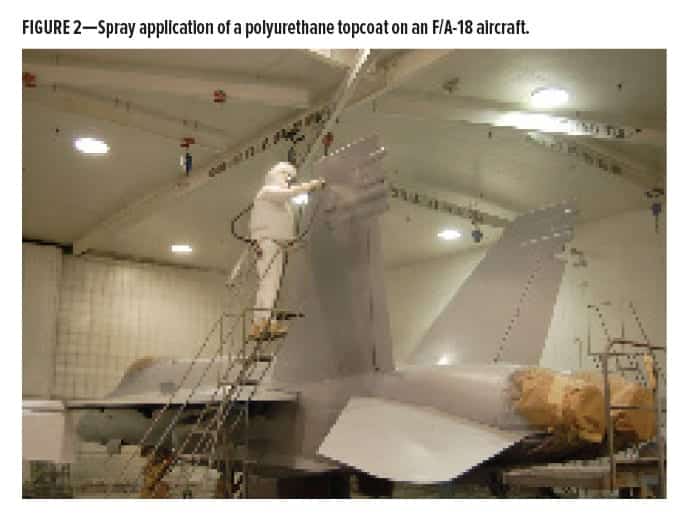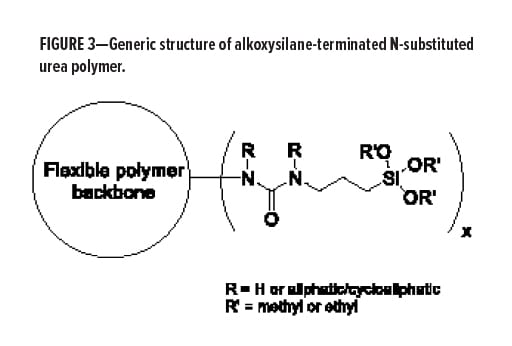By Erick Iezzi, Ph.D., U.S. Naval Research Laboratory
The U.S. Naval Research Laboratory (NRL) recently developed novel alkoxysilane-terminated N-substituted urea polymers for use in moisture-curable, single-component (1K) polysiloxane topcoats for military assets. These polymers demonstrate similar mechanical properties and chemical resistance to polyurethanes, yet do not contain harmful isocyanates. The polymers can be synthesized in a variety of polar and aromatic solvents to provide low viscosity solutions, thus allowing for the generation of topcoats that are free of hazardous air pollutants (HAPs) and contain low levels of volatile organic compounds (VOCs). These polymers have been primarily utilized to formulate 1K polysiloxane topcoats for use on the exterior of Navy surface ships and aircraft, yet they are applicable to a variety of non-military markets where exterior durable topcoats are required.
For Navy ships, the 1K polysiloxane topcoat is designed as a haze gray colored system that is <250 g/l VOCs, provides a semi-gloss finish once cured, will adhere to high solids epoxy primers, and offers enhanced weatherability and hydrocarbon resistance compared to legacy Navy topcoats. The coating can be brush- and roll-applied by sailors for touchup/repair applications or spray-applied by contractors during depot-level maintenance. For Navy aircraft, the 1K topcoat is designed as a camouflage gray colored system that is <300 g/l VOCs, is spray-applied via high-volume low-pressure (HVLP) equipment, provides a low-gloss finish once cured, and demonstrates comparable flexibility, weatherability, and hydrocarbon resistance to qualified polyurethane topcoats. Gloss topcoats for Navy aircraft have also been formulated using these novel polymers. Laboratory testing of these 1K polysiloxane topcoats to military specifications (MIL-Specs.) and demonstrations on military assets will be discussed herein.
INTRODUCTION
Legacy Surface Ship and Aircraft Topcoats
The Navy’s predominant surface ship topside (above the waterline) coatings for the past 50 years have been single-component (1K) silicone alkyds.1a-c These coatings were originally specified under TT-E-4902a (Enamel, Silicone Alkyd Copolymer, Semigloss—For Exterior and Interior Use) when first introduced, but have since been qualified to the requirements found in MIL-PRF-24635E, Type II/III2b (Coatings Systems, Weather-Resistant, Exterior Use).
Silicone alkyds have proven to be a “user friendly” technology for applicators because they are an all-in-one-can system that do not require the addition of components or a catalyst before application, have an indefinite pot life in a closed can, are free of hazardous isocyanates, and will crosslink (i.e., cure) even under the most adverse conditions. Unfortunately, the chemistry of silicone alkyds precludes adequate long-term performance on the exterior of Navy surface ships, which is evident by their loss of gloss and color fading to a light gray color within 9 to 12 months after application. Silicone alkyds formulated with low solar absorbing (LSA) pigments (i.e., titanium dioxide, yellow iron oxide, red iron oxide, and copper phthalocyanine blue) have been observed to color shift towards a pinkish hue after six months of exposure (Figure 1a). In addition, silicone alkyds exhibit insufficient surface hardness due to their low crosslink density, which enables running rust and soot to easily stain the surface and produce an unsightly appearance. As a result, it is common to find sailors over-coating aged silicone alkyds with fresh silicone alkyd (Figure 1b), thereby perpetuating a cycle of topside painting and increased maintenance costs to the Navy.
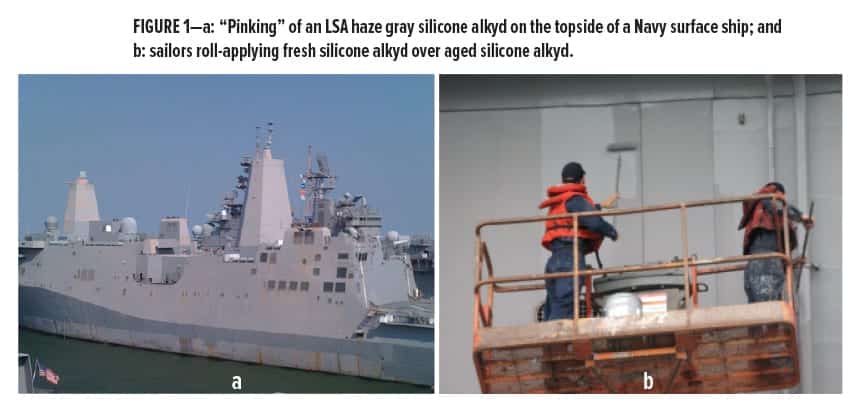 For years, silicone alkyds have provided the Navy with adequate performance; however, the need to maintain visual camouflage and aesthetics for longer periods of time, in addition to reducing maintenance costs as ship life cycles are extended, has meant that silicone alkyds can no longer provide the performance that is required for Navy ship topside coatings.
For years, silicone alkyds have provided the Navy with adequate performance; however, the need to maintain visual camouflage and aesthetics for longer periods of time, in addition to reducing maintenance costs as ship life cycles are extended, has meant that silicone alkyds can no longer provide the performance that is required for Navy ship topside coatings.
Two-component (2K) polysiloxane topside coatings, which are hybrid cure systems,3 have recently been qualified to MIL-PRF-24635E, Type V/VI requirements and implemented by the Navy. These coatings provide enhanced color and gloss stability, in addition to greater cleanability and hydrocarbon resistance, than the legacy silicone alkyds, yet they require the measuring and mixing of components before application which can result in insufficiently cured coatings and/or reduced performance if not combined and mixed properly. These systems also have a limited pot life once mixed, which can be troublesome for sailors attempting to paint on hot days. A high performance and nonhazardous single-component coating that will meet MIL-PRF-24635, Type V/VI requirements does not exist commercially.
For Navy and Marine Corps fixed and rotary wing aircraft, aliphatic polyurethane (PU) topcoats have been the technology used to provide visual camouflage, hydrocarbon resistance, flexibility, first-line corrosion resistance, and several other performance properties for over 30 years. These topcoats are two-component (2K) systems that are applied via high volume, low pressure (HVLP) spray equipment (Figure 2), and all systems are qualified to MIL-PRF-85285E4 (Coating: Polyurethane, Aircraft and Support Equipment) requirements. Although polyurethanes provide adequate exterior durability for aircraft, these coatings contain hazardous isocyanate-based materials, such as hexamethylene diisocyanate (HDI) and homopolymers thereof, which can cause serious health issues for coating applicators and those in proximity to airborne mists or off-gassing vapors. Exposure to isocyanates, especially during spray applications, can result in severe irritation to the skin, eyes, and lungs; swelling of the arms and legs; fever; symptoms of asthma; and sensitization.5a-d
In situations where National Institute of Occupational Safety and Health (NIOSH) permissible exposure limits (PELs) for HDI isocyanates cannot be exceeded,5d or where the use of isocyanates is prohibited, the exterior of Navy and Marine Corps aircraft are painted with a MIL-PRF-81352C6 (Aircraft Touch-Up) 1K topcoat, such as an acrylic or alkyd. Unfortunately, these technologies offer only short-term exterior color stability and hydrocarbon resistance compared to PU. The use of these systems for touch-up/repair of aircraft also results in a continuous downward spiral of rapid topcoat degradation, color fading, increased inspections, and repairs with inferior coatings, along with increased maintenance costs to the Navy. It should be noted that due to the inadequate exterior durability of MIL-PRF-81352C topcoats the Navy has recently approved the application of isocyanate-based polyurethanes in limited quantities for the repair of aircraft when deployed on carriers (CVNs). A 2K and isocyanate-free coatings system that will meet the performance requirements for aircraft topcoats does not exist commercially, let alone a single-component system.
Single-component topcoats that are isocyanate-free and provide enhanced performance properties (e.g., color stability) compared to qualified topcoats would be beneficial to both Navy surface ships and aircraft. Not only would these systems be user friendly for applicators (e.g., sailors, depot-level contractors) by eliminating the mixing of two or more components, 1K systems would potentially eliminate performance and appearance issues associated with improperly mixing multi-component systems. Single-component systems would also reduce the generation of hazardous waste and provide for a longer pot life.
NOVEL POLYMERS FOR SINGLE-COMPONENT POLYSILOXANE TOPCOATS
The Naval Research Laboratory (NRL) has recently developed novel isocyanate-free and moisture-curable alkoxysilane-terminated N-substituted urea polymers (Figure 3) for use in single-component polysiloxane topcoats for military and commercial applications.7a,b These polymers crosslink via hydrolysis of the alkoxysilanes and subsequent condensation of the resulting silanol groups to form a polysiloxane network, whereas the backbone of the polymer is composed of flexible aliphatic linkages. Polysiloxanes have an inherent durability advantage over traditional organic-based materials due to the presence of silicon-oxygen bonds. The Si−O bond, which has a bond dissociation energy (BDE) of 110 kcal/mol, is stronger than the carbon–carbon (C–C, 83 kcal/mol BDE) bonds found in all organic-based coatings, such as epoxies, thereby providing an increased resistance to oxidative degradation by ultraviolet (UV) radiation from sunlight.
EXPERIMENTAL PROCEDURE
NRL’s single-component polysiloxane topcoats were formulated by mixing the novel moisture-curable polymers with pigments, solvents, fillers, and additives to generate formulations with different levels of VOCs, viscosities, dry times, and gloss finishes.
The 1K polysiloxane topcoat for Navy surface ships was formulated as a haze gray (FED-STD-595 #26270) color, was <250 g/l of VOCs and free of hazardous air pollutants (HAPs), and cured to a semi-gloss (i.e., 45-60 gloss units at 60°) finish. This coating was roll-applied or drawn-down to achieve 2–4 mils of dry film thickness (DFT), then allowed to cure at ambient conditions (72°F, 50–60% RH) for 14 days before testing to MIL-PRF-24635E, Type V (high-durability coating), Class 2 (semi-gloss), Grade B (low-solar-absorbance) requirements. The majority of testing was performed over MIL-DTL-24441 and MIL-PRF-23236D epoxy primers on 6 x 12 x 1/8 in. blasted cold rolled steel panels, whereas flexibility testing was conducted over sanded 3 x 6 x 0.025 in. 3003 H14 aluminum panels. Atmospheric Exposure (i.e., outdoor) testing was conducted in Key West, FL. Qualified LSA silicone alkyds and 2K LSA polysiloxanes were applied at similar DFTs for comparative testing. Multiple gallons of the haze gray 1K polysiloxane were batched by a coating manufacturer for demonstrations on active surface ships in Norfolk, VA and San Diego, CA.
The 1K polysiloxane topcoat for Navy aircraft was formulated as a gray (FED-STD-595 #36375) color, was <300 g/l of VOCs and HAPs-free, and cured to a low-gloss/matte finish. The coating was spray-applied with high-volume, low-pressure (HVLP) spray equipment to achieve a DFT of ~2 mils, then was allowed to cure at ambient conditions (72°F, 50–60% RH) for 14 days before testing to MIL-PRF-85285E, Type IV (aircraft with extended weatherability, ≤420 g/l VOCs) requirements. The majority of tests were performed as a stack-up consisting of a MIL-PRF-85582D, Type II, Class C1 (barium chromate) waterborne epoxy primer and a MIL-DTL-81706B, Type I (hexavalent chromium) pretreatment over 3 x 6 x 0.020 in. aluminum alloy (AA) 2024-T3 panels. Flexibility testing of the 1K aircraft topcoat was conducted over 3 x 6 x 0.020 in. chromic acid anodized AA 2024-O panels without a primer. A qualified Type IV 2K PU topcoat was applied at similar DFTs to the 1K polysiloxane for comparative testing.
RESULTS
Single-Component Polysiloxane Topcoat for Navy Surface Ships
NRL’s 1K topside coating for surface ships was dry-to-touch (DTT) in 5–6 h and dry-hard (DH) in 8–9 h at 70°F and 50% relative humidity (RH). After 14 days of curing, the coating demonstrated a 5A adhesion rating according to ASTM D3359, Method A8 over both MIL-DTL-24441, Type IV epoxy and MIL-PRF-23236D, Type VI/VII high-solids epoxy primers that had cured for 24 h and 7 days, in addition to demonstrating a 5A adhesion rating over prepared (i.e., sanded and solvent wiped) silicone alkyds and two-component polysiloxanes. The 1K p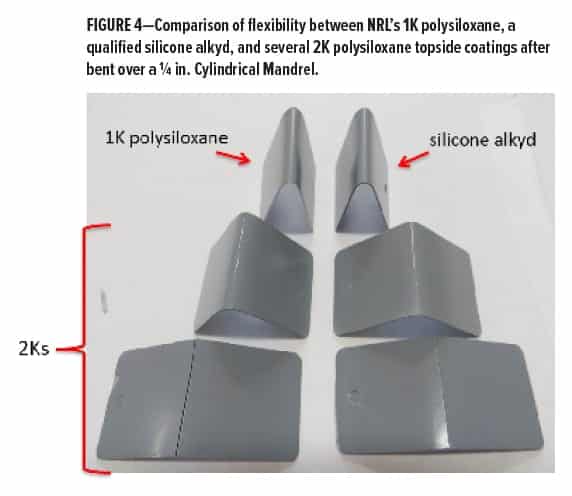 olysiloxane also possessed excellent hydrocarbon resistance and passed 100+ double rubs with a methyl ethyl ketone (MEK) soaked rag according to ASTM D54029 without marring or cut-through. Furthermore, the 1K polysiloxane passed a ¼ in. Cylindrical Mandrel Bend according to ASTM D52210 without cracking. Figure 4 shows a comparison of flexibility between NRL’s 1K polysiloxane topside coating, a qualified silicone alkyd, three qualified 2K polysiloxanes, and a non-qualified 2K polysiloxane after bent on a ¼ in. cylindrical mandrel.11 As can be seen in the photo, all 2K polysiloxanes cracked after partial bending, whereas the 1K polysiloxane and silicone alkyd did not. Even after being heated at 140°F for 24 h, the 1K polysiloxane was able to pass a Conical Mandrel Bend without cracking.
olysiloxane also possessed excellent hydrocarbon resistance and passed 100+ double rubs with a methyl ethyl ketone (MEK) soaked rag according to ASTM D54029 without marring or cut-through. Furthermore, the 1K polysiloxane passed a ¼ in. Cylindrical Mandrel Bend according to ASTM D52210 without cracking. Figure 4 shows a comparison of flexibility between NRL’s 1K polysiloxane topside coating, a qualified silicone alkyd, three qualified 2K polysiloxanes, and a non-qualified 2K polysiloxane after bent on a ¼ in. cylindrical mandrel.11 As can be seen in the photo, all 2K polysiloxanes cracked after partial bending, whereas the 1K polysiloxane and silicone alkyd did not. Even after being heated at 140°F for 24 h, the 1K polysiloxane was able to pass a Conical Mandrel Bend without cracking.
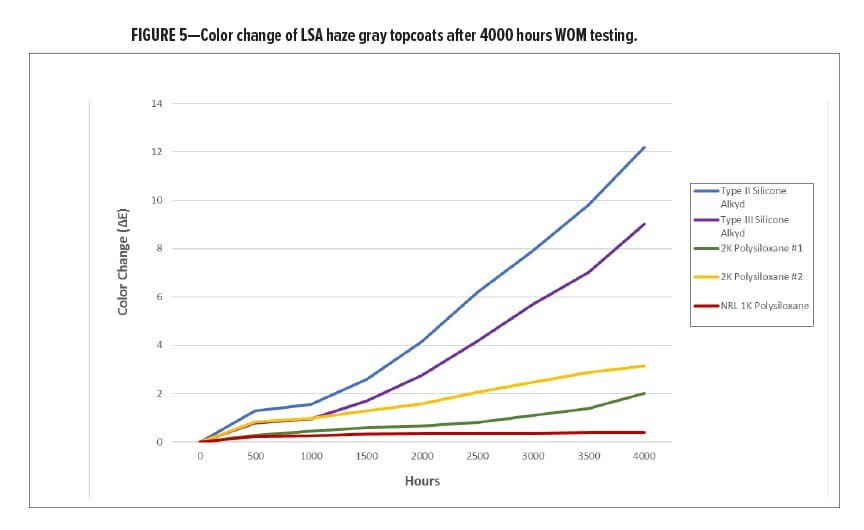 With regard to weatherability, the 1K polysiloxane demonstrated a color change (ΔE) of ~0.40 after 4000 h of accelerated weathering in a Xenon-Arc Weatherometer (WOM) chamber according to ASTM G155,12 whereas the color change for qualified silicone alkyds and two qualified 2K polysiloxanes was significantly greater (Figure 5). The 1K polysiloxane also demonstrated a gloss loss of ~23% compared to that of 50% or greater for the qualified topcoats. Furthermore, the 1K polysiloxane demonstrated a color change of only 0.24 after 300 h of accelerated weathering in a UV-B (313 nm bulb) chamber according to ASTM G154,13 in addition to a color change of 0.98 after 455 days on an outdoor exposure rack in Key West, FL.11
With regard to weatherability, the 1K polysiloxane demonstrated a color change (ΔE) of ~0.40 after 4000 h of accelerated weathering in a Xenon-Arc Weatherometer (WOM) chamber according to ASTM G155,12 whereas the color change for qualified silicone alkyds and two qualified 2K polysiloxanes was significantly greater (Figure 5). The 1K polysiloxane also demonstrated a gloss loss of ~23% compared to that of 50% or greater for the qualified topcoats. Furthermore, the 1K polysiloxane demonstrated a color change of only 0.24 after 300 h of accelerated weathering in a UV-B (313 nm bulb) chamber according to ASTM G154,13 in addition to a color change of 0.98 after 455 days on an outdoor exposure rack in Key West, FL.11
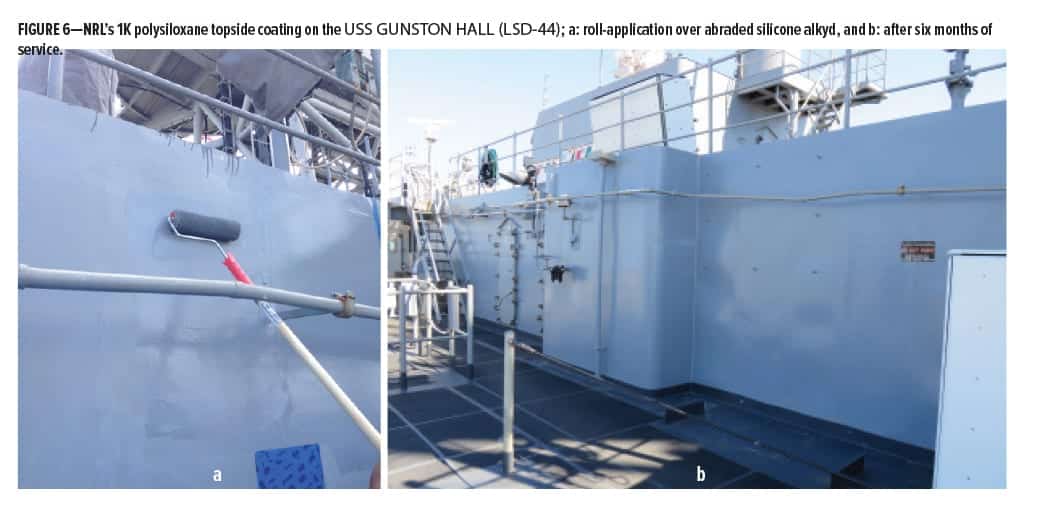 Multi-gallon quantities of the 1K polysiloxane for Navy surface ships were batched by a commercial coating manufacturer, and applications were conducted on several active ships over the past two years. In September 2016, the 1K polysiloxane was roll- and brush-applied by sailors on ~400 ft2 of a 06 Level Port Side bulkhead aboard the USS GUNSTON HALL (LSD-44). The substrate was aged and discolored silicone alkyd that was abraded with 80-grit sand paper and cleaned with fresh water. Figure 6a shows the 1K haze gray polysiloxane coating as it was being rolled on the bulkhead. The coating was inspected in March 2017 (Figure 6b), and, after six months of service, the average color change (∆E) was 0.2 with an average loss of gloss of ~4.1%. It should be noted that the photos were taken in the shade, thus the coating appears to have a blue-gray color.
Multi-gallon quantities of the 1K polysiloxane for Navy surface ships were batched by a commercial coating manufacturer, and applications were conducted on several active ships over the past two years. In September 2016, the 1K polysiloxane was roll- and brush-applied by sailors on ~400 ft2 of a 06 Level Port Side bulkhead aboard the USS GUNSTON HALL (LSD-44). The substrate was aged and discolored silicone alkyd that was abraded with 80-grit sand paper and cleaned with fresh water. Figure 6a shows the 1K haze gray polysiloxane coating as it was being rolled on the bulkhead. The coating was inspected in March 2017 (Figure 6b), and, after six months of service, the average color change (∆E) was 0.2 with an average loss of gloss of ~4.1%. It should be noted that the photos were taken in the shade, thus the coating appears to have a blue-gray color.
Single-Component Polysiloxane Topcoat for Navy Aircraft
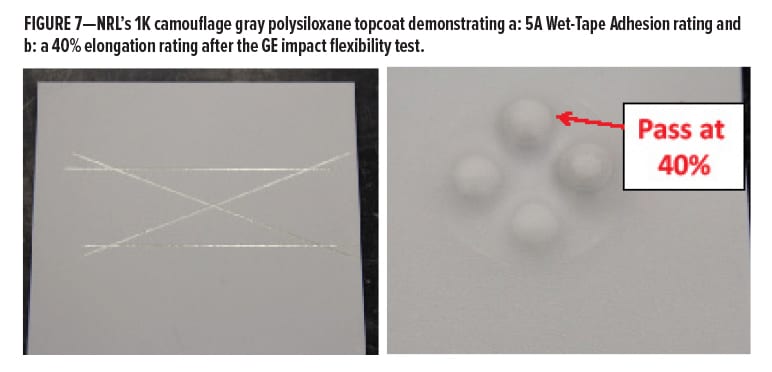
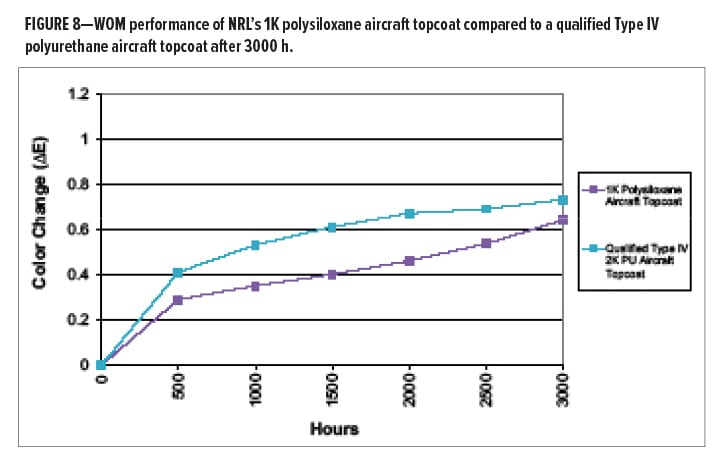 NRL’s 1K camouflage gray polysiloxane topcoat for aircraft was dry-hard (DH) in 2.5 h and demonstrated gloss units of 4.8 (at 60°) and 5.0 (at 85°) after 14 days of curing at 70°F and 50–60% RH. The cured coating demonstrated a wet-tape adhesion rating of 5A over a MIL-PRF-85582E, Type II, Class C1 epoxy primer (Figure 7a). The topcoat also passed immersion resistance in several fluids (i.e., lubricating oil, hydraulic, and JP-5 fuel); passed MEK resistance after 25 double rubs with an MEK soaked rag; and passed the heat, cleanability, and humidity resistance tests. The topcoat was not evaluated for Skydrol resistance. In addition, the topcoat passed the flexibility requirements of: (1) 40% elongation (Figure 7b) after an ambient temperature GE Impact according to ASTM D6905,14 and (2) zero cracking after a low-temperature (-60°F) bend on a 2-in. cylindrical mandrel.
NRL’s 1K camouflage gray polysiloxane topcoat for aircraft was dry-hard (DH) in 2.5 h and demonstrated gloss units of 4.8 (at 60°) and 5.0 (at 85°) after 14 days of curing at 70°F and 50–60% RH. The cured coating demonstrated a wet-tape adhesion rating of 5A over a MIL-PRF-85582E, Type II, Class C1 epoxy primer (Figure 7a). The topcoat also passed immersion resistance in several fluids (i.e., lubricating oil, hydraulic, and JP-5 fuel); passed MEK resistance after 25 double rubs with an MEK soaked rag; and passed the heat, cleanability, and humidity resistance tests. The topcoat was not evaluated for Skydrol resistance. In addition, the topcoat passed the flexibility requirements of: (1) 40% elongation (Figure 7b) after an ambient temperature GE Impact according to ASTM D6905,14 and (2) zero cracking after a low-temperature (-60°F) bend on a 2-in. cylindrical mandrel.
For weatherability, the 1K aircraft topcoat demonstrated a color change (ΔE) of 0.64 when tested for 3000 h in a Xenon-Arc Weatherometer chamber (Figure 8) according to ASTM G155, whereas a qualified Type IV polyurethane topcoat demonstrated a color change of 0.73 after the same period.
The 1K polysiloxane aircraft topcoat demonstrated the ability to meet the majority of MIL-PRF-85285, Type IV performance requirements, and demonstrations on Navy aircraft are currently being discussed.
CONCLUSIONS
NRL has recently developed novel isocyanate-free, moisture-curable polymers for use in single-component (1K) polysiloxane topcoats for Navy surface ships and aircraft. In addition to being free of hazardous isocyanate-based materials, these topcoats contain reduced levels of VOCs; are HAPs-free; and provide excellent hydrocarbon resistance, flexibility, and weatherability. The 1K topcoat designed for surface ships has been scaled-up to multi-gallon quantities by acoating manufacturer for roll, brush, and spray demonstrations. To date, the 1K polysiloxane topside coating has proven to outperform all qualified topside coatings. The 1K polysiloxane topcoat for aircraft has demonstrated the ability to provide similar performance to qualified polyurethanes when tested in the laboratory. These single-component topcoats will provide applicators with a “user friendly” system that eliminates the measuring and mixing of multiple components, eliminates potential curing and performance issues associated with incorrectly mixing components, in addition to providing for a longer pot-life and reducing the amount of hazardous waste generated from unused mixed materials.
ACKNOWLEDGMENTS
The author would like to thank the Naval Sea Systems Command (NAVSEA) Paint Center of Excellence (PCoE) Program and the Environmental Security Technology Certification Program (ESTCP WP-201506) for supporting this research. The author also thanks collaborators at the Naval Air Warfare Center−Aircraft Division (NAWC-AD), GK Consulting, Corrosion Control Services, and NAVSEA’s Corrosion Control Assistance Team (CCAT) members.
References
1.a) Witucki, G.L. “The Evolution of Silicone Based Technology in Coatings,” Dow Corning Corporation, 2003; b) Hiles, C.R., Golding, B., and Shreve, R.N., “Copolymerization of Alkyd Silicones for Coatings,” Ind. Eng. Chem., 47, p 1418-1424 (1955); c) Wicks, Z.W., Jones, F.N., Pappas, S.P., and Wicks, D.A., Organic Coatings: Science and Technology, 3rd Ed., Wiley, 2007.
2.a) TT-E-490E “Enamel, Silicone Alkyd Copolymer, Semigloss (For Exterior and Interior Use),” September 25, 1975; b) MIL-PRF-24635E Performance Specification, “Coating Systems, Weather-Resistant, Exterior Use,” September 15, 2009.3
3 .Witucki, G., “Next Generation Polysiloxane Hybrid Coatings,” Polym. Paint Col. J., p 22-24 (November 2012).
4. MIL-PRF-85285E Performance Specification, “Coating: Polyurethane, Aircraft and Support Equipment,” January 12, 2012.
5.a) “Isocyanates: Working Safely” California Department of Public Health, (www.cdph.ca.gov/programs/hesis/Documents/iso.pdf), May 2014; b) Nakashima, K., Takeshita, T., and Morimoto, K. “Occupational Hypersensitivity Pneumonitis Due to Isocyanates: Mechanisms of Action and Cases Reported in Japan.” Ind. Health, 39, 269-279 (2001); c) “Preventing Asthma and Death from Diisocyanate Exposure DHHS,” NIOSH Publication Number 96-111 (www.cdc.gov/niosh/docs/96-111/); d) “NIOSH Pocket Guide to Chemical Hazards: Hexamethylene Diisocyanate” (www.cdc.gov/niosh/npg/npgd0320.html).
6. MIL-PRF-81352C Performance Specification, “Coating, Aircraft Touch-Up,” June 16, 2005.
7. a) Iezzi, E.B. “Single-Component Coatings Having Alkoxysilane-Terminated N-Substituted Urea Resins,” U.S. Patent, 9,221,942, December 29, 2015; b) Iezzi, E.B. “Single-Component Moisture-Curable Coating Based on N-Substituted Urea Polymers with Extended Chains and Terminal Alkoxysilanes,” U.S. Patent 9,139,753, September 22, 2015.
8. ASTM D3359, “Standard Test Methods for Measuring Adhesion by Tape Test.”
9. ASTM D5402, “Standard Practice for Assessing the Solvent Resistance of Organic Coatings Using Solvent Rubs.
10. ASTM D522, “Standard Test Methods for Mandrel Bend Test of Attached Organic Coatings.”
11. Iezzi, E. and Tagert, J., “Single-Component Polysiloxane Topcoat for Navy Surface Ships,” J. Protect. Coat. and Linings, p 26-31 (November 2016).
12. ASTM G155, “Standard Practice for Operating Xenon Arc Light Apparatus for Exposure of Non-Metallic Materials.”
13. ASTM G154, “Standard Practice for Operating Fluorescent Ultraviolet (UV) Lamp Apparatus for Exposure of Nonmetallic Materials.”
14. ASTM D6905, “Standard Test Method for Impact Flexibility of Organic Coatings.”
Presented at the 2017 CoatingsTech Conference, sponsored by ACA, March 20-22, in Cleveland, OH.
CoatingsTech | August 2017, Vol. 14, No. 8
